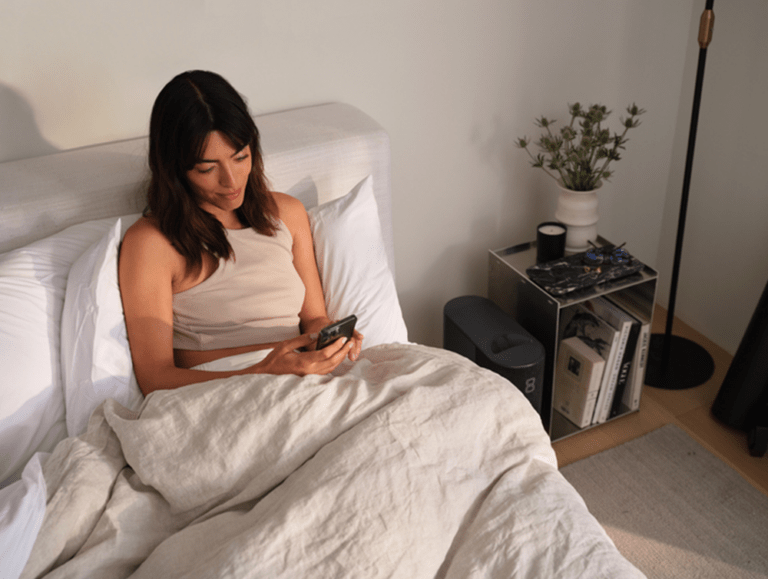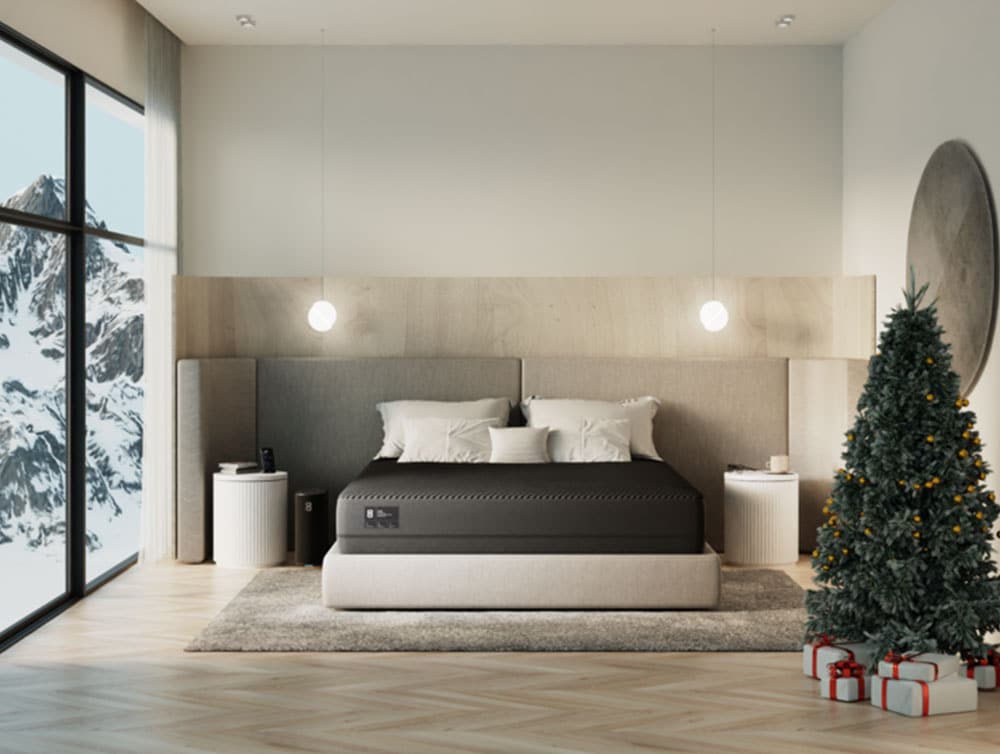
If you want to live a long and healthy life, getting quality sleep is vital. Sleep is essential for our overall well-being, and the quality of sleep we get can significantly impact our physical and mental health.
Unfortunately, around 50 to 70 million people in the US have sleep issues – that’s an insane number, considering the US population is about 330 million[1].
So what’s the deal? Why are we all tossing and turning the night away?
While various factors contribute to a good night’s sleep (stress, caffeine intake, health issues, physical comfort), one often overlooked element is temperature. The temperature of both your body and your sleep environment plays a crucial role in achieving a restful night’s sleep.
In this article, we’ll dive into the details of exactly why the temperature in your sleeping environment matters and what you can do to optimize sleep temps so you can wake up ready to take on the day.
Understanding the Sleep-Wake Cycle
Before diving into the impact of temperature on sleep, let’s talk about the basics of the sleep-wake cycle. Our body’s internal clock, known as the circadian rhythm, regulates our sleep patterns. It relies on various external cues to determine when it’s time to wake up and when it’s time to sleep.
For instance, the sun’s position in the sky can either send a signal to wake up and get going or wind it down and get to bed. The same goes for meal timing. If you’ve just consumed a large meal, your body won’t be too keen on laying down for a night of rest. While most people know that when the sun goes down, their body will be more inclined to sleep and that eating a large meal before bed will likely cause some disturbance, sleep temperature is a detail that often slips through the cracks[2].
Your body’s core temperature naturally fluctuates over the course of a day. In the evening, your core body temperature begins to drop, signaling to your body that it’s time to prepare for sleep. Conversely, in the morning, your core body temperature rises, helping you wake up and feel alert. But if you sleep in a room that is too hot or too cold, it can mess with these natural fluctuations[3].
The Ideal Sleep Temperature
Maintaining a consistent, cooler room temperature, typically between 60°F (15°C) and 67°F (19°C), is ideal for optimizing sleep[4]. These cooler temperatures help your body regulate its core temperature, which aligns with the natural drop in core temperature needed for restful sleep. Furthermore, a cooler sleep environment can help improve your sleep, heart rate, and HRV[5].
The Impact of Temperature on Sleep Quality
Alright, now that you know the basics, how exactly does temperature impact sleep quality?
- Falling Asleep Faster: A cooler sleep environment helps you fall asleep faster. When your room is too warm, your body has to work harder to cool down, delaying sleep onset. Cooler temperatures facilitate this process, making it easier to drift off into slumber.
- Deeper Sleep: A consistent room temperature supports deeper sleep. During the REM stage of the sleep cycle, your body loses some ability to regulate its temperature. A cooler environment helps mitigate temperature fluctuations, allowing you to enjoy longer periods of deep, restorative sleep[6].
- Reduced Nighttime Awakenings: Fluctuations in room temperature can trigger awakenings during the night. Waking up due to discomfort from heat or cold can disrupt your sleep cycle, making it difficult to get back to sleep. A well-controlled sleep environment can minimize these disturbances, contributing to more stable HR and HRV patterns.
- Enhanced REM Sleep: REM sleep is crucial for memory consolidation, problem-solving, and emotional processing. A cooler room temperature promotes extended REM sleep periods, potentially improving cognitive function and emotional well-being[7].
- Better Sleep for Insomniacs: Maintaining an optimal sleep environment temperature can significantly benefit individuals suffering from insomnia. Cool room temperatures have been shown to reduce insomnia symptoms, making it easier for those with sleep disorders to get the rest they need[8].
Practical Tips for Optimizing Your Sleep Environment
So, how do we cool down our sleep without hopping into an ice bath every night? (Not that a nightly ice bath would be a bad idea…but I digress).
- Invest in Bedding: Choose breathable, moisture-wicking bedding materials such as cotton or linen. These materials help regulate your body temperature by allowing for better airflow and moisture control.
- Use a Programmable Thermostat: Install a programmable thermostat that can adjust the room temperature to your preference shortly before bedtime.
- Block Out Light: Utilize blackout curtains or blinds to block out external light sources that can raise the room temperature and disrupt your sleep.
- Ventilation: Use a fan or open a window to maintain fresh air circulation and prevent overheating in your bedroom.
- Cooling Mattress and Pillows: Consider investing in a cooling mattress cover like Eight Sleep’s Pod Cover or cooling pillows designed to regulate your body temperature and keep you comfortable throughout the night. Intelligent mattress covers like the Eight Sleep Pod Cover add heating and cooling to any bed and help regulate dynamic temperatures to improve sleep.
- Limit Electronic Devices: Avoiding screens at least an hour before bedtime can help your body prepare for sleep.
- Stay Hydrated: Stay adequately hydrated throughout the day while being mindful of drinking too much water right before bedtime to prevent disruptive trips to the bathroom.
- Warm Baths or Showers: Taking a warm bath or shower before bedtime can help lower your body temperature, preparing it for sleep[9].
Takeaway
The impact of temperature on sleep quality is undeniable. Maintaining a cooler sleep environment is a simple yet highly effective way to improve the quality of your sleep. By understanding the role of temperature in your sleep-wake cycle and making the necessary adjustments to your sleep environment, you can enjoy deeper, more restful sleep, leading to better physical and mental health. Sweet dreams await those who embrace the sleep thermometer.
References
- https://www.nhlbi.nih.gov/health/sleep-deprivation
- https://www.nigms.nih.gov/education/fact-sheets/Pages/circadian-rhythms.aspx
- Okamoto-Mizuno, Kazue, and Koh Mizuno. “Effects of thermal environment on sleep and circadian rhythm.” Journal of physiological anthropology 31.1 (2012): 1-9.
- https://health.clevelandclinic.org/what-is-the-ideal-sleeping-temperature-for-my-bedroom/
- Moyen, Nicole E., et al. “Sleeping for one week on a temperature-controlled mattress cover improves sleep and cardiovascular recovery.” (2023).
- Okamoto-Mizuno, Kazue, and Koh Mizuno. “Effects of thermal environment on sleep and circadian rhythm.” Journal of physiological anthropology 31.1 (2012): 1-9.
- Okamoto-Mizuno, Kazue, et al. “Effects of humid heat exposure on human sleep stages and body temperature.” Sleep 22.6 (1999): 767-773.
- Lack, Leon C., et al. “The relationship between insomnia and body temperatures.” Sleep medicine reviews 12.4 (2008): 307-317.
- Haghayegh, Shahab, et al. “Before-bedtime passive body heating by warm shower or bath to improve sleep: A systematic review and meta-analysis.” Sleep medicine reviews 46 (2019): 124-135.












